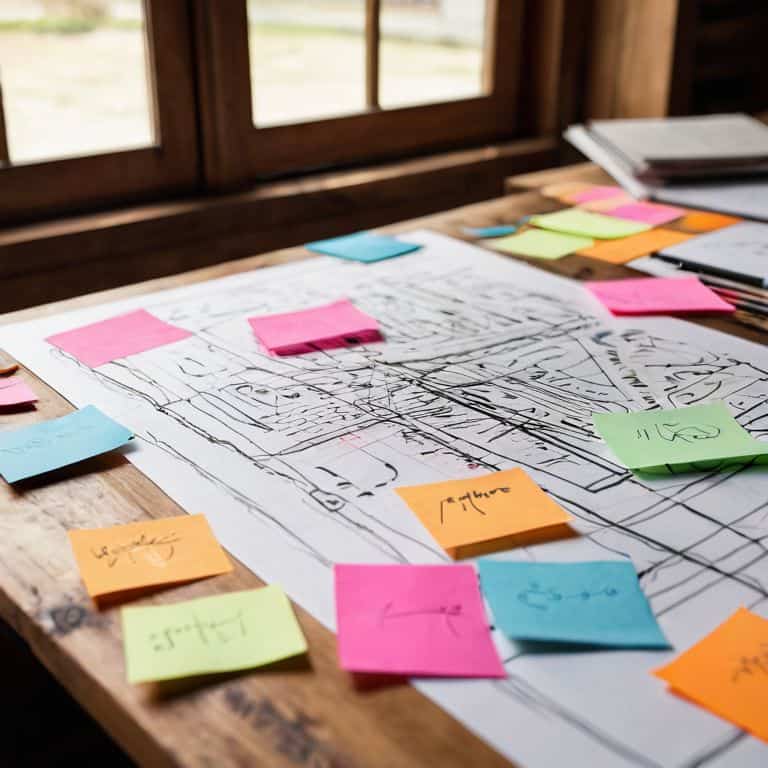I still remember the first time I heard about the Feynman technique for learning. It was in a crowded conference room, where a self-proclaimed “productivity guru” was touting it as a magic bullet for retaining information. But as I listened to the pitch, I couldn’t help but feel a sense of frustration – it all sounded so _overly simplistic_. The idea that a single technique could solve all our learning woes seemed like a gross oversimplification of the complex process of learning. I’ve spent years helping people create systems to navigate chaos, and I knew that there had to be more to the Feynman technique than just a catchy name.
As someone who’s passionate about breaking down complex topics into actionable steps, I want to assure you that this article will be different. I’ll provide you with a _no-nonsense_ guide to implementing the Feynman technique for learning in your daily life. I’ll share my personal experience with the technique, including the step-by-step frameworks I’ve developed to make it more accessible. My goal is to empower you with practical advice, not to waste your time with vague promises or overly complicated theories. By the end of this article, you’ll have a clear understanding of how to apply the Feynman technique to improve your learning outcomes, and you’ll be equipped with the tools you need to start seeing real results.
Table of Contents
Feynman Technique for Learning

When it comes to active recall methods, the Feynman technique is a powerful tool for reinforcing learning and improving retention. By teaching someone else what you’ve learned, you’re forced to clarify your own understanding and identify any gaps in your knowledge. This process helps to solidify information in your long-term memory, making it easier to recall later on. I’ve seen this technique work wonders for my clients who struggle with retaining complex information.
One of the key benefits of this approach is that it encourages metacognition in education, helping you to develop a better understanding of how you learn and what works best for you. By breaking down complex topics into simple explanations, you’ll be able to identify areas where you need more practice or review. This technique can be used in conjunction with other learning strategies, such as spaced repetition benefits, to create a comprehensive approach to learning and retention.
To get started with this technique, try creating a mnemonic device for memory to help you associate new information with something you already know. Then, practice teaching the concept to someone else, using interleaving learning strategies to help you switch between different types of information and deepen your understanding. By combining these techniques, you’ll be able to develop a robust learning framework that helps you to retain information and apply it in real-world situations.
Active Recall Methods That Stick
When it comes to retaining information, active recall is a powerful tool. This involves actively recalling information from memory rather than simply re-reading it. By doing so, you’re strengthening the connection between neurons in your brain, making it easier to recall the information later.
To make active recall even more effective, I recommend using flashcards. Write a key term or question on one side and the answer or explanation on the other. Quiz yourself by covering the answer side and trying to recall the information from memory. This simple technique can be a game-changer for learning and retention.
Spaced Repetition Benefits Explained
To truly maximize the Feynman technique, it’s essential to understand the power of spaced repetition. This involves reviewing material at increasingly longer intervals to help solidify it in your long-term memory. By doing so, you’re not just passively re-reading information, but actively recalling it, which strengthens your understanding and retention.
Implementing spaced repetition into your learning routine can have a significant impact on your ability to retain complex information. This method allows you to focus on the most critical pieces of information and review them in a way that complements your natural learning rhythm, making the learning process more efficient and effective.
Mastering Complex Topics Simply

To truly master complex topics, it’s essential to break them down into manageable chunks. I like to use flowcharts to visualize the relationships between different concepts, making it easier to identify areas where I need more focus. By doing so, I can create a clear learning path that’s tailored to my needs.
When it comes to retaining information, active recall methods are incredibly effective. One strategy I recommend is using spaced repetition to review material at increasingly longer intervals. This helps to solidify the information in your long-term memory, making it easier to recall when you need it. Additionally, incorporating mnemonic devices for memory can be a fun and creative way to associate new information with something you already know.
By combining these strategies with interleaving learning strategies, you can create a powerful framework for learning. This involves switching between different types of material or problems to help deepen your understanding and improve your ability to apply what you’ve learned. As you work through complex topics, remember to practice metacognition in education by regularly reflecting on your own thought processes and adjusting your approach as needed.
Interleaving Strategies for Deeper Understanding
When it comes to grasping complex topics, interleaving is a powerful strategy that can help you deepen your understanding. By switching between different types of material or problems, you can build a more nuanced and interconnected web of knowledge. This approach can be particularly effective when combined with active recall methods, as it allows you to see the relationships between different concepts and ideas.
To implement interleaving in your learning routine, try mixing up your study materials. For example, if you’re trying to learn a new language, you might switch between grammar exercises, vocabulary flashcards, and listening comprehension practice. This can help you develop a more well-rounded understanding of the subject matter and improve your ability to apply what you’ve learned in different contexts.
Mnemonic Devices for Better Memory
To improve memory retention, I rely on mnemonic devices that help associate new information with something already familiar. This technique has been a game-changer for my urban beekeeping hobby, where I need to recall specific details about bee behavior and hive management. By creating mental shortcuts, I can quickly access the information I need, even in the midst of a chaotic beekeeping session.
When it comes to creating these devices, I break it down into simple, manageable steps. I start by identifying the key information I want to remember, and then I create a mental or visual association that helps me recall it. This can be a rhyme, a mind map, or even a simple acronym – whatever works best for the specific information I’m trying to retain.
5 Essential Tips to Supercharge Your Learning with the Feynman Technique

- Break down complex topics into simple, bite-sized chunks that you can easily explain to someone else
- Use active recall methods like flashcards, quizzes, or summarizing notes in your own words to reinforce new information
- Create concept maps or diagrams to visualize relationships between different ideas and identify knowledge gaps
- Teach the material to someone else, either in person or through writing, to solidify your own understanding and identify areas for improvement
- Review and refine your understanding of a topic regularly, using spaced repetition to help solidify it in your long-term memory and make connections to other relevant concepts
Key Takeaways to Boost Your Learning
Apply the Feynman technique by simplifying complex topics into easy-to-understand language to improve retention and understanding
Utilize active recall methods such as spaced repetition and mnemonic devices to make learning more efficient and effective
Integrate interleaving strategies into your study routine to deepen your understanding of complex topics and make connections between different pieces of information
Breaking Down Complexity
The Feynman technique isn’t just a learning method – it’s a mindset shift that proves you don’t have to be intimidated by complex topics, because with the right framework, anything can be broken down into manageable, bite-sized pieces.
Sloane Kendrick
Conclusion: Simplifying Learning with the Feynman Technique
To recap, we’ve explored the Feynman technique for learning, diving into active recall methods that make information stick, such as spaced repetition and its numerous benefits. We also examined how to master complex topics simply by utilizing mnemonic devices for better memory and interleaving strategies for a deeper understanding. By applying these principles, you can significantly enhance your learning outcomes and develop a more efficient approach to absorbing new information.
As you move forward, remember that the key to successful learning lies in breaking down complex topics into manageable parts. Don’t be overwhelmed by the sheer amount of information out there – instead, focus on creating your own systems and frameworks for understanding and retaining knowledge. With persistence and the right tools, you can unlock a world of new possibilities and make learning a fun, engaging process that empowers you to grow.
Frequently Asked Questions
How do I apply the Feynman technique to complex topics that have a lot of abstract concepts?
To tackle complex topics with abstract concepts, I recommend breaking them down into bite-sized chunks using flowcharts. Identify key concepts, then create a visual map to connect the dots between them. This helps to clarify relationships and reveal patterns, making it easier to understand and retain the information.
What are some common mistakes people make when trying to use the Feynman technique for learning and how can I avoid them?
Let’s get real – when using the Feynman technique, people often make mistakes like overcomplicating explanations or not practicing active recall. To avoid these pitfalls, I recommend creating a simple flowchart to break down complex topics and setting a schedule for regular review sessions. This will help you stay on track and ensure you’re actually retaining the information.
Can the Feynman technique be used in conjunction with other learning methods, such as spaced repetition or interleaving, for even better results?
Absolutely, I’m a big fan of combining techniques for maximum impact. The Feynman technique pairs perfectly with spaced repetition and interleaving – try using Feynman to distill complex concepts, then apply spaced repetition to reinforce key terms, and interleaving to connect new ideas to existing knowledge.
